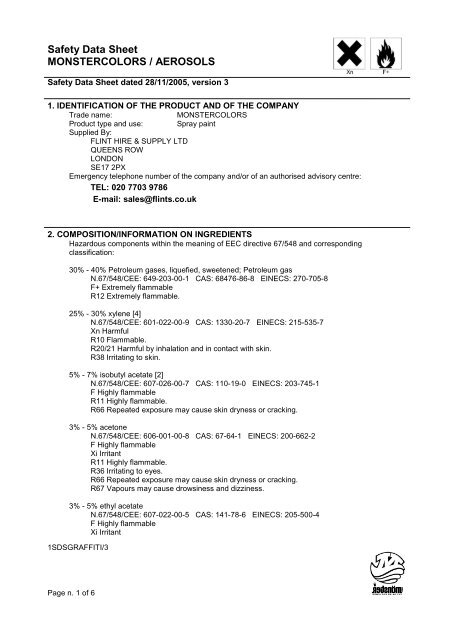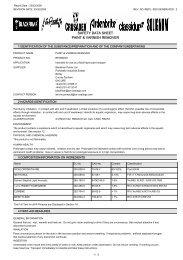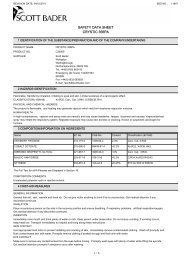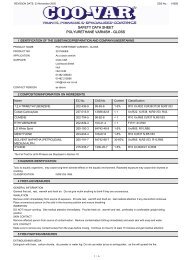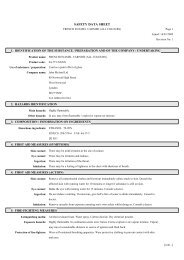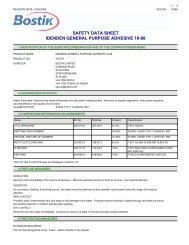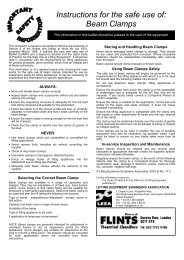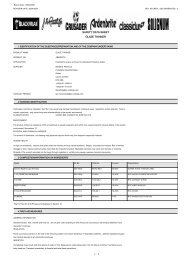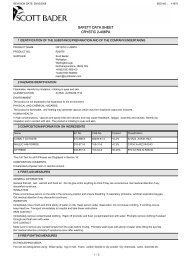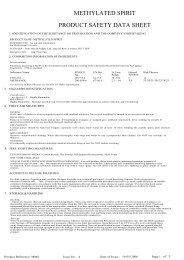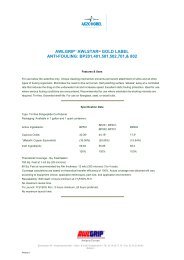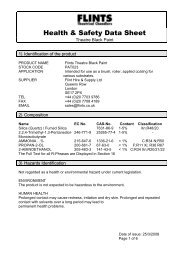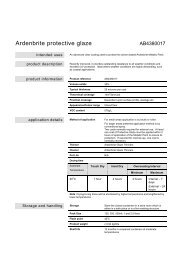Safety Data Sheet MONSTERCOLORS / AEROSOLS - Flint Hire ...
Safety Data Sheet MONSTERCOLORS / AEROSOLS - Flint Hire ...
Safety Data Sheet MONSTERCOLORS / AEROSOLS - Flint Hire ...
You also want an ePaper? Increase the reach of your titles
YUMPU automatically turns print PDFs into web optimized ePapers that Google loves.
<strong>Safety</strong> <strong>Data</strong> <strong>Sheet</strong><br />
<strong>MONSTERCOLORS</strong> / <strong>AEROSOLS</strong><br />
<strong>Safety</strong> <strong>Data</strong> <strong>Sheet</strong> dated 28/11/2005, version 3<br />
1. IDENTIFICATION OF THE PRODUCT AND OF THE COMPANY<br />
Trade name:<br />
<strong>MONSTERCOLORS</strong><br />
Product type and use: Spray paint<br />
Supplied By:<br />
FLINT HIRE & SUPPLY LTD<br />
QUEENS ROW<br />
LONDON<br />
SE17 2PX<br />
Emergency telephone number of the company and/or of an authorised advisory centre:<br />
TEL: 020 7703 9786<br />
E-mail: sales@flints.co.uk<br />
2. COMPOSITION/INFORMATION ON INGREDIENTS<br />
Hazardous components within the meaning of EEC directive 67/548 and corresponding<br />
classification:<br />
30% - 40% Petroleum gases, liquefied, sweetened; Petroleum gas<br />
N.67/548/CEE: 649-203-00-1 CAS: 68476-86-8 EINECS: 270-705-8<br />
F+ Extremely flammable<br />
R12 Extremely flammable.<br />
25% - 30% xylene [4]<br />
N.67/548/CEE: 601-022-00-9 CAS: 1330-20-7 EINECS: 215-535-7<br />
Xn Harmful<br />
R10 Flammable.<br />
R20/21 Harmful by inhalation and in contact with skin.<br />
R38 Irritating to skin.<br />
5% - 7% isobutyl acetate [2]<br />
N.67/548/CEE: 607-026-00-7 CAS: 110-19-0 EINECS: 203-745-1<br />
F Highly flammable<br />
R11 Highly flammable.<br />
R66 Repeated exposure may cause skin dryness or cracking.<br />
3% - 5% acetone<br />
N.67/548/CEE: 606-001-00-8 CAS: 67-64-1 EINECS: 200-662-2<br />
F Highly flammable<br />
Xi Irritant<br />
R11 Highly flammable.<br />
R36 Irritating to eyes.<br />
R66 Repeated exposure may cause skin dryness or cracking.<br />
R67 Vapours may cause drowsiness and dizziness.<br />
3% - 5% ethyl acetate<br />
N.67/548/CEE: 607-022-00-5 CAS: 141-78-6 EINECS: 205-500-4<br />
F Highly flammable<br />
Xi Irritant<br />
1SDSGRAFFITI/3<br />
Page n. 1 of 6
<strong>Safety</strong> <strong>Data</strong> <strong>Sheet</strong><br />
<strong>MONSTERCOLORS</strong> / <strong>AEROSOLS</strong><br />
R11 Highly flammable.<br />
R36 Irritating to eyes.<br />
R66 Repeated exposure may cause skin dryness or cracking.<br />
R67 Vapours may cause drowsiness and dizziness.<br />
1% - 3% ethylbenzene<br />
N.67/548/CEE: 601-023-00-4 CAS: 100-41-4 EINECS: 202-849-4<br />
F Highly flammable<br />
Xn Harmful<br />
R11 Highly flammable.<br />
R20 Harmful by inhalation.<br />
1% - 3% 2-methoxy-1-methylethyl acetate<br />
N.67/548/CEE: 607-195-00-7 CAS: 108-65-6 EINECS: 203-603-9<br />
Xi Irritant<br />
R10 Flammable.<br />
R36 Irritating to eyes.<br />
3. HAZARDS IDENTIFICATION<br />
The product catches fire with extreme ease, even at temperatures below 0 °C.<br />
Without sufficient ventilation formation of explosive mixtures with air may be possible . Pressurized<br />
container. Protect from sunlight and do not expose to temperature exceeding 50°C. Heat can<br />
increase pressure inside the container whith possibility of explosion . Fire can explode container :<br />
fire can be propagated at distance by the jump of container . High concentration of gas can cause<br />
loss of senseless .<br />
The product is harmful following acute exposure to it and poses a serious health threat if inhaled or<br />
brought into contact with the skin.<br />
If brought into contact with the skin, the product causes appreciable inflammation, with erythema,<br />
scabs, and oedema.<br />
4. FIRST AID MEASURES<br />
Contact with skin:<br />
Immediately take off all contaminated clothing.<br />
Areas of the body that have - or are only even suspected of having - come into contact with<br />
the product must be rinsed immediately with plenty of running water and possibly with soap.<br />
Contact with eyes:<br />
Do not use eyewash or ointment of any kind (before obtaining an examination or advice from<br />
an eye specialist).<br />
Wash immediately with water for at least 10 minutes.<br />
Swallowing:<br />
Do not under any circumstances induce vomiting. OBTAIN A MEDICAL EXAMINATION<br />
IMMEDIATELY.<br />
Give liquid paraffin to drink; do not give milk or animal or vegetable fats of any kind.<br />
Inhalation:<br />
Ventilate the premises. The patient is to be removed immediately from the contaminated<br />
premises to rest in a well ventilated area. OBTAIN MEDICAL ATTENTION.<br />
5. FIRE-FIGHTING MEASURES<br />
1SDSGRAFFITI/3<br />
Page n. 2 of 6
<strong>Safety</strong> <strong>Data</strong> <strong>Sheet</strong><br />
<strong>MONSTERCOLORS</strong> / <strong>AEROSOLS</strong><br />
Heat can increase pressure inside the container whith possibility of explosion . Fire can explode<br />
container : fire can be propagated at distance by the jump of container .<br />
Recommended extinguishers:<br />
CO2 , dry chemical fire extinguisher , foam<br />
Extinguishers not to be used:<br />
None in particular.<br />
Risks arising from combustion:<br />
Avoid inhaling the fumes.<br />
Protective equipment:<br />
Use protection for the respiratory tract.<br />
High concentration of gas can cause loss of senseless .<br />
Cool the containers exposed to the fire with water.<br />
6. ACCIDENTAL RELEASE MEASURES<br />
Measures for personal safety:<br />
Use a mask, gloves and protective clothing.<br />
Environmental measures:<br />
Limit leakages with earth or sand.<br />
Eliminate all unguarded flames and possible sources of ignition. Do not smoke.<br />
If the product has escaped into a water course, into the drainage system, or has<br />
contaminated the ground or vegetation, notify the competent authorities.<br />
Cleaning methods:<br />
Rapidly recover the product. To do so, wear a mask and protective clothing.<br />
If the product is in a liquid form, stop it from entering the drainage system.<br />
Recover the product for re-use if possible, or for elimination. The product might, where<br />
appropriate, be absorbed by inert material.<br />
After the product has been recovered, rinse the area and materials involved with water.<br />
7. HANDLING AND STORAGE<br />
Handling precautions:<br />
Avoid contact and inhalation of the vapours. See, too, paragraph 8 below.<br />
Operate in well ventilated place . Vapours are more weighty then air . Vapours may form<br />
explosive mixture with air .<br />
Do not vaporize on flames or incandescent material .<br />
Do not make hole or burn after use .<br />
Do not eat or drink while working.<br />
Do not smoke while working.<br />
Incompatible materials:<br />
None in particular.<br />
Storage conditions:<br />
Keep away from unguarded flame, sparks, and heat sources. Avoid direct exposure to<br />
sunlight.<br />
Avoid accumulating electrostatic charge.<br />
Instructions as regards storage premises:<br />
Cool and adequately ventilated.<br />
<strong>Safety</strong> electric system.<br />
8. EXPOSURE CONTROLS / PERSONAL PROTECTION<br />
Precautionary measures:<br />
Give adequate ventilation to the premises where the product is stored and/or handled.<br />
1SDSGRAFFITI/3<br />
Page n. 3 of 6
<strong>Safety</strong> <strong>Data</strong> <strong>Sheet</strong><br />
<strong>MONSTERCOLORS</strong> / <strong>AEROSOLS</strong><br />
Respiratory protection:<br />
Use adequate protective respiratory equipment, e.g. CEN/FFP-2(S) or CEN/FFP-3(S).<br />
Protection for hands:<br />
Use protective gloves that provides comprehensive protection, e.g. P.V.C., neoprene or<br />
rubber.<br />
Eye protection:<br />
Use close fitting safety goggles and/or visor conforming to BS 2092 GRADE 1).<br />
Protection for skin:<br />
Use clothing that provides comprehensive protection to the skin, e.g. cotton, rubber, PVC or<br />
viton.<br />
Exposure limit(s) (ACGIH):<br />
xylene [4]<br />
TLV TWA: 100 ppm, A4 - 434 mg/m3, A4 TLV STEL: 150 ppm, A4 - 651 mg/m3, A4<br />
isobutyl acetate [2]<br />
TLV TWA: 150 ppm - 713 mg/m3<br />
acetone<br />
TLV TWA: 500ppm, A4 - 1188mg/m3 A4 TLV STEL: 750ppm, A4 - 1782mg/m3, A4<br />
ethyl acetate<br />
TLV TWA: 400 ppm, A4 - 1440 mg/m3, A4<br />
ethylbenzene<br />
TLV TWA: 100 ppm - 434 mg/m3 TLV STEL: 125 ppm - 543 mg/m3<br />
2-methoxy-1-methylethyl acetate<br />
TLV TWA: 275 mg/m3 ( MAK )<br />
9. PHYSICAL AND CHEMICAL PROPERTIES<br />
Appearance and colour: Liquid<br />
Odour:<br />
Characteristic<br />
Can Volume :<br />
210 I 270 I 405 I 520 I 800 ml<br />
Product Volume :<br />
150 I 200 I 300 I 400 I 600 ml<br />
Flash point:<br />
< 0 °C Abel Pensky<br />
Gas flammability:<br />
- 80 °C Abel Pensky<br />
Autoignition temperature: 435 °C<br />
Propellent explosivity : 1.8 ÷ 9.5 % in volume aria<br />
Vapour pressure: 5.0 bar +/- 0.3 - 20 °C<br />
Deformation Pression : 15 bar<br />
Explosion Pressione : 18 ÷ 20 bar<br />
Relative density: 0.95 +/- 0.05<br />
Solubility in water:<br />
Partial<br />
10. STABILITY AND REACTIVITY<br />
Conditions to avoid:<br />
Avoid accumulating electrostatic charge.<br />
Substances to avoid:<br />
Avoid contact with combustible materials. The product could catch fire.<br />
Hazardous decomposition products:<br />
None.<br />
11. TOXICOLOGICAL INFORMATION<br />
The concentration of each substance should be borne in mind in assessing the toxicological effects<br />
deriving from the preparation.<br />
Set out below is the toxicological information relating to the main substances in the preparation.<br />
1SDSGRAFFITI/3<br />
Page n. 4 of 6
<strong>Safety</strong> <strong>Data</strong> <strong>Sheet</strong><br />
<strong>MONSTERCOLORS</strong> / <strong>AEROSOLS</strong><br />
xylene [4]<br />
LD50 (RAT) ORAL: 5000 mg/Kg<br />
isobutyl acetate [2]<br />
LD50 (RAT) ORAL: 15000 mg/Kg<br />
acetone<br />
LD50 (RABBIT) ORAL: 5300 mg/Kg<br />
ethyl acetate<br />
LD50 (RABBIT) ORAL: 4935 mg/Kg<br />
12. ECOLOGICAL INFORMATION<br />
Adopt good working practices, so that the product is not released into the environment.<br />
13. DISPOSAL CONSIDERATIONS<br />
Recover, if possible. Send to authorised disposal plants or for incineration under controlled<br />
conditions. In so doing, comply with the local and national regulations currently in force.<br />
14. TRANSPORT INFORMATION<br />
ADR-UN number: 1950<br />
ADR-Class:<br />
CL. 2 - 5F<br />
ADR-Shipping Name: AEROSOL<br />
ADR-Label: 2.1<br />
IMDG-Class:<br />
CL. 2,1 AEROSOL<br />
IMDG-Page: 2102<br />
15. REGULATORY INFORMATION<br />
88/379/EEC (Classification and Labelling):<br />
Symbols:<br />
Xn Harmful<br />
F+ Extremely flammable<br />
R Phrases:<br />
R12 Extremely flammable.<br />
R20/21 Harmful by inhalation and in contact with skin.<br />
R38 Irritating to skin.<br />
S Phrases:<br />
S13 Keep away from food, drink and animal feedingstuffs.<br />
S16 Keep away from sources of ignition - No smoking.<br />
S29 Do not empty into drains.<br />
S33 Take precautionary measures against static discharges.<br />
S43 In case of fire, use CO2 , dry chemical fire extinguishe , foam .<br />
S46 If swallowed, seek medical advice immediately and show this container or label.<br />
S25 Avoid contact with eyes.<br />
S2 Keep out of reach of children.<br />
S36/37 Wear suitable protective clothing and gloves.<br />
Special Provisions:<br />
Pressurized container. Protect from sunlight and do not expose to temperatures exceeding 50<br />
°C. Do not pierce or burn, even after use.<br />
Do not spray on a naked flame or any incandescent material. Keep away from sources of<br />
ignition - No smoking. Keep out of reach of children.<br />
1SDSGRAFFITI/3<br />
Page n. 5 of 6
<strong>Safety</strong> <strong>Data</strong> <strong>Sheet</strong><br />
<strong>MONSTERCOLORS</strong> / <strong>AEROSOLS</strong><br />
Contents:<br />
xylene [4]<br />
Where applicable, refer to the following regulatory provisions :<br />
Directive 82/501/EEC ('Activities linked to risks of serious accidents') and subsequent<br />
amendments.<br />
16. OTHER INFORMATION<br />
Main bibliographic sources:<br />
ECDIN - Environmental Chemicals <strong>Data</strong> and Information Network - Joint Research Centre,<br />
Commission of the European Communities<br />
SAX's DANGEROUS PROPERTIES OF INDUSTRIAL MATERIALS - Eight Edition - Van<br />
Nostrand Reinold<br />
ACGIH - Treshold Limit Values - 1997 edition<br />
The information contained herein is based on our state of knowledge at the above-specified date. It<br />
refers solely to the product indicated and constitutes no guarantee of particular quality.<br />
It is the duty of the user to ensure that this information is appropriate and complete with respect to<br />
the specific use intended.<br />
This MSDS cancels and replaces any preceding release.<br />
1SDSGRAFFITI/3<br />
Page n. 6 of 6


